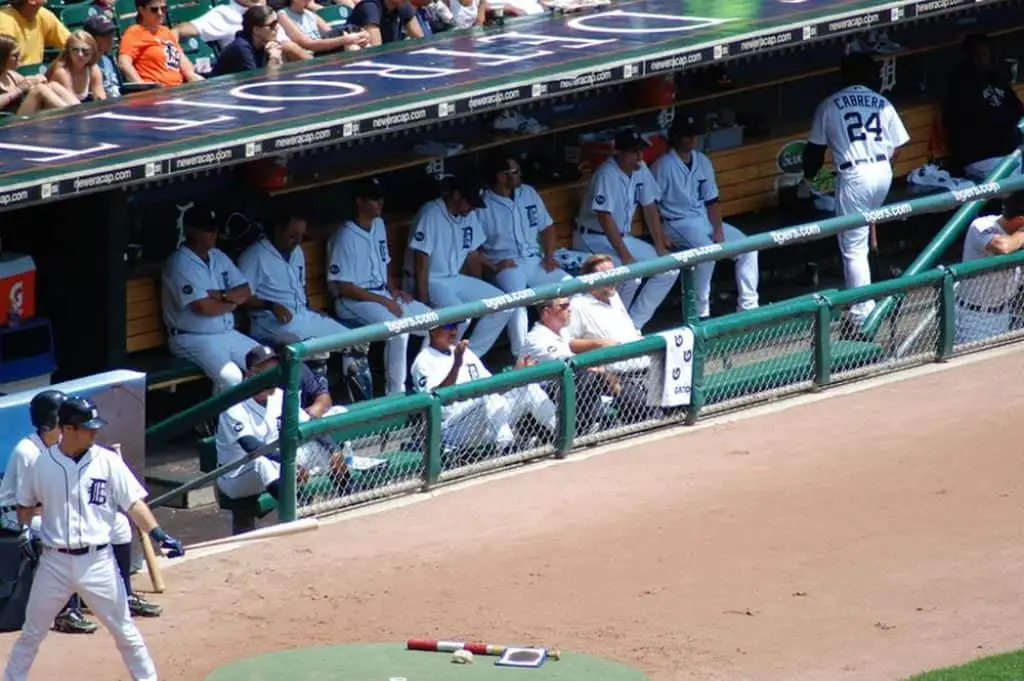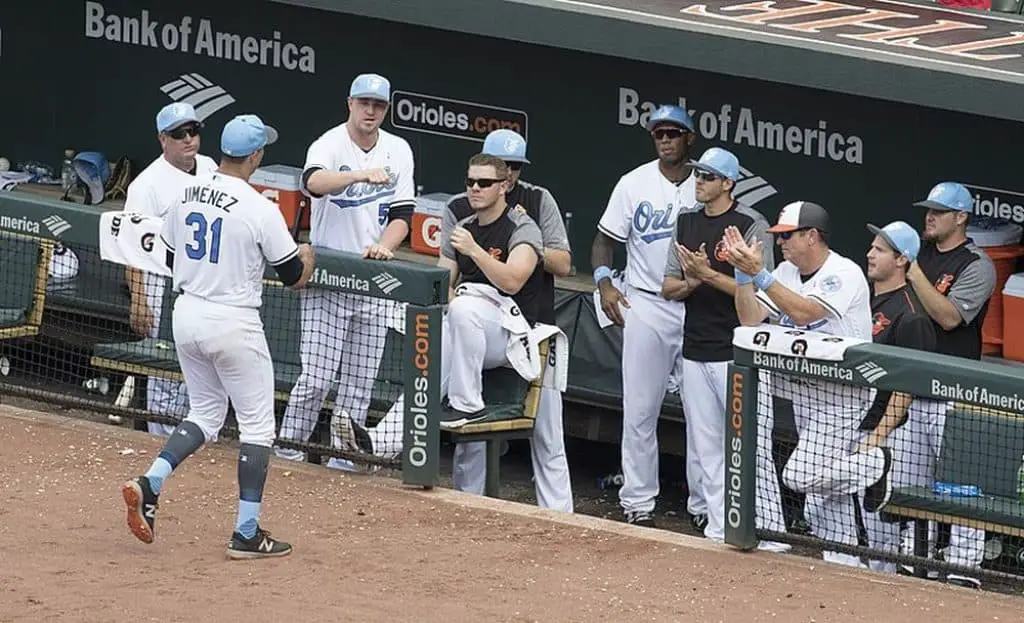Which Dugout Is Home Team? (In-Depth Guide)
During a baseball game, most of the attention is on what’s happening on the field.
However, as anyone who’s ever played baseball will tell you, a baseball team’s success often starts in the dugout.
Initially created as a way to make better sight lines for spectators sitting behind the team area, dugouts have become a significant and integral part of the game.
It’s where the team’s character is developed and where players and coaches get together and create the chemistry that is a key ingredient in developing a winning team.
Knowing the importance of a dugout, it’s logical that the home team will look to have theirs on the spot that seems the most advantageous.
However, you’ve probably noticed that in different stadiums, the home dugout may be positioned differently.
Below, I’ll explain where is the home team dugout side and what factors influence its location on the field.
So, let’s dive in!
Table of Contents
Which Dugout Is Home Team?
If you’ve ever seen a ballgame, you know that every ballpark features two dugouts, one for the home team and the other for the visitors.
They’re located in the foul territory, with one situated between the home plate and the first base and the other between the home and the third.
There are plenty of rules in the baseball rulebook on who can sit in the dugout and about governing the play in and around the dugout.
However, there is no rule about which team should be on the first-base side and which on the third-base side.
So, which team will sit in which dugout is completely arbitrary, and the decision is completely left to the discretion of the home team.
However, it’s safe to say that most home teams sit on the first-base dugout, although it’s not particularly rare to see them occupy the one on the third-base side.
How Do Home Teams Choose Their Dugout Side?

As baseball teams play half of their games at home, they usually look for any advantage they can get and that includes choosing the side for their dugout.
While the location of the dugout sometimes may be decided purely on the whim of a team’s owner, in most cases, there are more practical reasons involved.
Home teams will look to place their dugout on whichever side they feel will be more comfortable for their players and staff and could bring even the tiniest edge over the visiting team.
So, when deciding where to place their dugout, teams take numerous factors into consideration.
Often, when building a new stadium, they will explicitly request from the architectural firm designing the project to situate the home dugout in a way that will provide some sort of advantage over the visitors.
Below, I’ll look into the most common reasons for choosing a particular side.
Strategy
One of the first things baseball teams think about when selecting the side for their home dugout is how it will help their manager and coaches influence the game.
In the earlier days of baseball, plenty of managers also served as third-base coaches.
For that reason, in many ballparks, especially older ones, the home dugout was situated on the third-base side as it meant a shorter walk for the managers between innings.
On the other hand, the best view of the game is from the first-base side, which is also where most of the close plays happen.
This is why many managers prefer to sit there as it helps them convey the changes in the game strategy to the players.
Also, they’re not blocked from seeing pitches to the right-handed batters who are in majority.
Plus, the unobstructed view from here gives them more leverage when having a disagreement with umpires.
Comfort
The comfort of both players and the coaching staff also plays a big role when deciding the side for the home dugout.
The dugout intended for the players of the home team is often larger, more comfortable, and better equipped than one for the visitors.
In some cases, it may even feature air conditioning or heating while visitors’ dugout is without such amenities.
The comfortable dugout is especially important because, as you probably know, players are not the only ones to sit there.
Managers, coaches, athletic trainers, and batboys also sit on the bench during games. Plus, players usually store their equipment, such as bats, helmets, gloves, etc, in the dugout.
So, the dugout can get crowded rather easily and some extra space allows players to feel comfortable, get their proper rest and focus on the game.
The Proximity Of The Clubhouse
Another factor is often which side of the field has a better clubhouse.
Dugouts are often directly connected to the clubhouse, so players can directly access their lockers from the field.
This is a particularly big factor when the team is moving into the preexisting facility, where the layout is already set.
For example, while the Nationals played at RFK Stadium, the home dugout was on the third-base side as that’s where the better facilities were located.
The Giants have their dugout at the third base because the stadium design couldn’t fit the larger and nicer locker room facility on the first-base side.
Weather Factors
Probably the most important reason for choosing either the first or third-base side for the home dugout is the angle at which the sun rays fall onto the stadium during the day games.
Facing direct sunlight for the better part of the day can be very problematic for the players, especially on hot summer days.
As they spend plenty of time on the bench, if exposed to too much sunlight they can get exhausted, dehydrated, or even get a sunburn.
Because of this, most teams will place their home dugout on the side that’s better shielded from the sun.
This is particularly the case at the lower levels of competition where most games are played during the day.
Also, besides avoiding being baked in the sun, the shaded dugout enables a better view of the game, as players on the bench don’t have to squint all the time due to the direct sunlight.
Where Are Home Dugouts Located At Major League Ballparks?

As the location of the home dugout is not tied by any rules and is rather arbitrary, MLB stadiums feature home dugouts on either side of the home plate.
The best example of this is that even the two oldest and most storied ballparks are different on this matter.
At Wrigley Field, home of the Chicago Cubs, the home dugout is located on the third-base side.
This is because the third base is shielded from the sun from noon onward, while the first base is in the direct sunlight during the later innings of day games.
The opposite is the case at Fenway Park, where the home dugout is on the first-base side. Still, the majority of home dugouts, both in the AL and NL, are on the first-base side.
Each league features 9 ballparks where this is the case, while both AL and NL have 6 stadiums featuring a home dugout at the third base.
MLB Teams With Home Dugouts On The First-Base Side
The following MLB teams and stadiums have their home dugouts on the first-base side:
- Atlanta Braves (Truist Park)
- Baltimore Orioles (Oriole Park at Camden Yards)
- Boston Red Sox (Fenway Park)
- Cincinnati Reds (Great American Ball Park)
- Colorado Rockies (Coors Field)
- Houston Astros (Minute Maid Park)
- Kansas City Royals (Kauffman Stadium)
- Milwaukee Brewers (American Family Field)
- Minnesota Twins (Target Field)
- New York Mets (Citi Field)
- New York Yankees (Yankee Stadium)
- Philadelphia Phillies (Citizens Bank Park)
- Seattle Mariners (T-Mobile Park)
- St. Louis Cardinals (Busch Stadium)
- San Diego Padres (Petco Park)
- Tampa Bay Rays (Tropicana Field)
- Texas Rangers (Globe Life Field)
- Washington Nationals (Nationals Park)
MLB Teams With Home Dugouts On The Third-Base Side
The home dugout is located on the third-base side at the following MLB stadiums:
- Arizona Diamondbacks (Chase Field)
- Chicago Cubs (Wrigley Field)
- Chicago White Sox (Guaranteed Rate Field)
- Cleveland Guardians (Progressive Field)
- Detroit Tigers (Comerica Park)
- Los Angeles Angels (Angel Stadium of Anaheim)
- Los Angeles Dodgers (Dodger Stadium)
- Miami Marlins (loanDepot Park)[4]
- Oakland Athletics (RingCentral Coliseum)
- Pittsburgh Pirates (PNC Park)
- San Francisco Giants (Oracle Park)
- Toronto Blue Jays (Rogers Centre)
Conclusion
The location of the dugout may seem irrelevant at first but, as you can see, that’s usually not the case.
By choosing where to place their dugout, home teams can gain plenty of small advantages over the visitors.
As baseball is a game often decided by the tiniest of margins, every little thing helps. Most of the strategies and moves on the field are planned in the dugout.
It’s a place that the manager uses as his battle station, from which he pulls the strings and runs the game.
That’s why teams often carefully consider all the benefits and drawbacks of placing the home dugout on either side of the home plate.
Both first-base and third-base sides have their perks, but the decision on where the home dugout will mostly depend on the particular conditions at a certain stadium.




